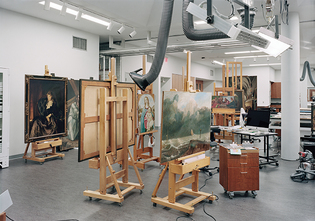
An-My Lê ’93MFA
Acquired this spring by
the Yale Center for British Art, the photo shown here—Fragment II:
Restoration of J. M. W. Turner’s Port Ruysdael, Yale Center for British Art, New Haven, Connecticut, 2018—is the first piece by an alumna of the Yale School of Art to enter the center’s collections.
View full image
J. M. W. Turner’s seascape Port Ruysdael (1826–7) was in need of repair. The looming cumulus storm clouds, at once massive and ethereal, had been abraded by long-ago cleanings, obscuring the artist’s signature atmospheric tactics. There was a tear to fix. And so in 2017, the Yale Center for British Art sent the painting, which shows a sloop struggling to make it to port, to the conservation lab on West Campus.
That’s where An-My Lê ’93MFA picked up the trail. Like the British Romantic painter, the Vietnamese American artist is known for visually opulent works that depict the theater and fog of war. Lê’s tool, though, is the large-format view camera, and her medium is color film.
To make her art, Lê has been embedded with various US military branches and has chronicled maneuvers and rehearsals for combat missions. In Virginia and North Carolina, she documented Vietnam War reenactments. (In order to participate, the artist, who had fled Vietnam with her family in 1975, signed up to play an enemy combatant.) Her series Silent General includes a set for a period film about a Civil War deserter, Confederate monuments in various settings, and Saturday Night Live’s simulation of the Oval Office.
Throughout, the documentary roots of Lê’s work strategically highlight the subjective nature of her medium, and of cultural norms dictating what’s considered real, fiction, news, or entertainment. “For me all photography is fiction,” says the artist, whose lush images play off the tension between the beauty of natural landscapes and the horrific events that transpire in war. Her influences include landscape photography, war photography, photojournalism, and European painting—particularly Turner.
“I’m interested in complicated beauty, a dark underside to beauty, so that notion of the sublime became very important,” she says. “In Turner, there is so much about the description of the ship and the ports and the details. And there’s a part that is more abstract, that is about the air, the sea, the sun, the light, that sense of the ineffable. In a way, photography does that for me.”
With a fiction embedded in its title—the work is named in homage to Dutch painter Jacob van Ruisdael, not for a real place—Port Ruysdael holds particular resonance for Lê. When she learned the painting was in the lab, she asked for permission to photograph it. The conservator assumed she meant a phone camera. Lê arrived with her gear. In the restoration lab, where fictions are made into facts, she would transform Turner’s homage to an earlier master into the subject of her own work.
Her photo, Fragment II: Restoration of J. M. W. Turner’s Port Ruysdael, Yale Center for British Art, New Haven, Connecticut, 2018, depicts Turner’s maritime scene behind the scenes. Perched on an easel, it’s captured from the side, not facing the viewer—it’s not on view, after all. Rather, it’s in conversation with Botticelli, Titian, Bellows, and other artists, a moment of casual intimacy that unfolds amidst the lab’s equipment, tools, and orderly geometry.
Fragment II has been traveling in the exhibit An-My Lê: On Contested Terrain, whose last stop is this winter at the Milwaukee Art Museum. Then the photograph heads back to New Haven—to the Yale Center for British Art, which recently acquired it. (The work is the first by a Yale School of Art alumna to enter the collections.)
Next year, when curators reinstall the second-floor collection galleries, they will hang Fragment II alongside Port Ruysdael. Lê’s piece is also slated to appear in the center’s celebration of Turner’s 250th birthday in 2025.
How does Lê feel about having her work connect across generations with her artistic predecessor? “I’m thrilled,” she says. “I think it will be interesting—the dialogue between photography and painting.”
It’s a pairing that might be described as sublime.
 loading
loading